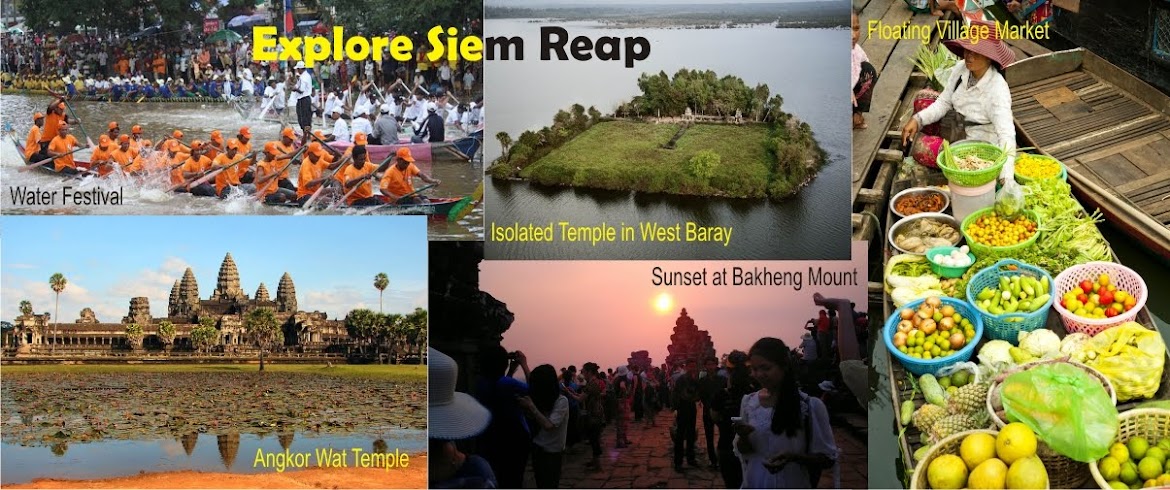This monument was built between the middle of the 12th and the early part of the 13th century, as a Mahayana Buddhist monastery, in the style of Bayon, with gates surmounted by colossal faces (240). As with all monuments of this type, the Buddhist iconography has been removed from the reliefs. Many of the lintels and pediments clearly show the contours of the image of Buddha which has carefully been effaced, in contrast to the surrounding worshippers and other decorative elements, which have remained untouched.
The monument is in a very precarious condition, but some pediments are intact. Noticeable are:
- Gopura I West
Eastern face: predicting with the upper registers damaged, depicting people around a finely decorated building in which Rama and Seta stand (242). It is surrounded by people in motion, possible dancing, or rejoicing at the return of Rama to his palace of Auodhya.
- Gopura I North
Southern face: in the upper register Buddha in meditation; in the o=lower register a personage standing between two elephants.
- Gopura II East
Pediment with four registers: at the top, a defaced image of the Buddha in a decorated temple (241); in the next, figure, possibly the king, totally prostrate on the ground; at the base, two superimposed registers of worshippers.
Another pediment on three registers, depicts Buddha in meditation under the bodhi tree, between acolytes and apsaras in the upper register; below, are two rows of worshippersm
The northern tower, with Lokeshvara faces on the external enclosure, has interesting pediments, probably showing Ramayana scenes (243).
TA NEI
This Buddhist temple was built towards the end of the 12th century by Jayavarman VII the small gopuras of the exterior enclosure are probably slightly later. As with the other temples of Jayavarman VII, the reliefs narrating Buddhist stories have been defaced. However, several interesting pediments are still in place.
- Gpura II East
Eastern face: Lokeshvara standing on a lotus between apsaras and flying personages; on the lower register some kneeling worshippers and devotees with large stomachs (245).
- Gopura I South
Northern face, lower pediment with a large-scale Kneeling personage blessing two children in a palace surrounded by apsaras, below, there is a row of worshippers (246).
- Gopura I North
Southern face, a horseman brandishing a sword, above two registers of worshippers (244).
- Central sanctuary
Northern face: a person standing in a junk makes a gesture of blessing surrounded by flying figures with parasols, The pediment facing west represents, on two registers, the episode when the Buddha-to-be cuts off his hair, or is simply in a meditative state (defaced), while the lower register depicts his horse Balaha amongst worshippers.
Other pediments are much less well-preserved: some feature an erased image of the Buddha in meditation under the Bodhi tree, amongst acolytes, or on a pedestal amongst worshippers.
Neak Poan Temple
This temple (248),built by Jayavarman VII in the last quarter of the 12th century, was laden from the outset with intense symbolism. Its pool was intended to cleanse the sins of those who bathed therein, and the temple was to be like a boat crossing the ocean of the existence.
It is finely decorated, and its narrative reliefs are focused on the Bodhisattva Lokeshvara who figures in the large images sculpted on the four doors of the shrine of this circular island (247). Above each image there is a pediment (much dilapidated) narrating an episode in the life of Buddha: to the east, the Cutting of the hair; to the North, the Great departure; to the West, buddhain meditation under the bodhi tree; the Southern pediment is completely eroded. The four small chapels surrounding the square pool have multiple pediments also depicting Buddhist motifs (249 and 250).
I the pool surrounding the shrine, may be seen the statue representing the legend of the Balaha horse (88,page 65).

No comments:
Post a Comment